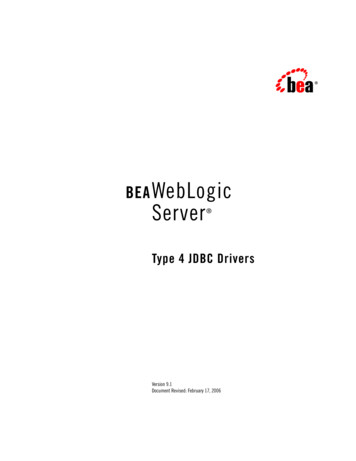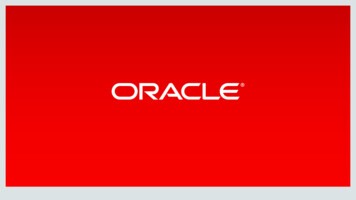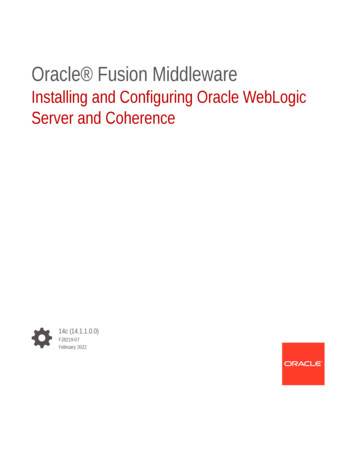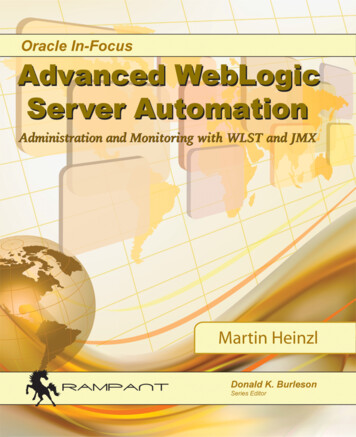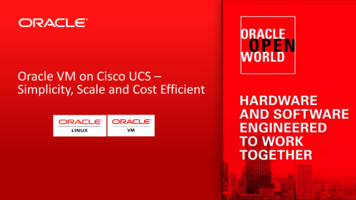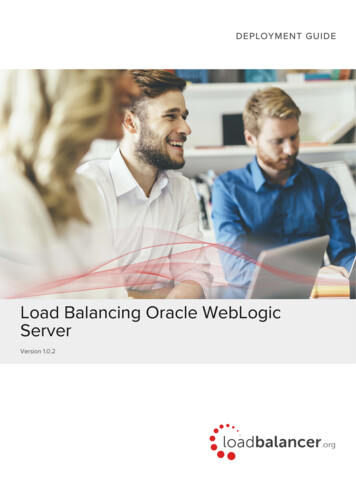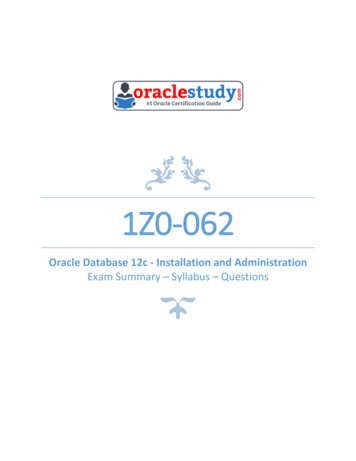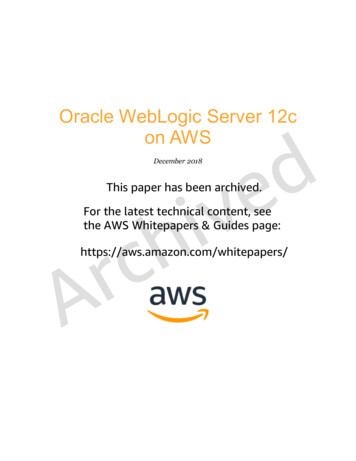
Transcription
Oracle WebLogic Server 12con AWSdeDecember 2018vihThis paper has been archived.For the latest technical content, seethe AWS Whitepapers & Guides page:crAhttps://aws.amazon.com/whitepapers/
Amazon Web Services – Oracle WebLogic 12c on AWS 2018, Amazon Web Services, Inc. or its affiliates. All rights reserved.NoticesThis document is provided for informational purposes only. It represents AWS’scurrent product offerings and practices as of the date of issue of this document,which are subject to change without notice. Customers are responsible formaking their own independent assessment of the information in this documentand any use of AWS’s products or services, each of which is provided “as is”without warranty of any kind, whether express or implied. This document doesnot create any warranties, representations, contractual commitments,conditions or assurances from AWS, its affiliates, suppliers or licensors. Theresponsibilities and liabilities of AWS to its customers are controlled by AWSagreements, and this document is not part of, nor does it modify, any agreementbetween AWS and its customers.vihdecrAPage 2
Amazon Web Services – Oracle WebLogic 12c on AWSContentsIntroduction5Oracle WebLogic on AWS6Oracle WebLogic Components6Oracle WebLogic Architecture on AWS8Auto Scaling your Oracle WebLogic Cluster15deMonitoring your Infrastructure19AWS Security and Compliance20Oracle WebLogic on AWS Use CasesvihConclusionContributorsDocument RevisionscrAPage 323242525
Amazon Web Services – Oracle WebLogic 12c on AWSAbstractThis whitepaper provides guidance on how to deploy Oracle WebLogic Server12c-based applications on AWS. This paper provides a reference architectureand information about best practices for high availability, security, scalability,and performance when you deploy Oracle WebLogic Server 12c-basedapplications on AWS. Also included is information about cost optimizationusing AWS Auto Scaling.deThe target audience of this whitepaper is Solution Architects, SystemsArchitects, and System Administrators with a basic understanding of cloudcomputing, AWS, and Oracle WebLogic 12c.vihcrAPage 4
Amazon Web Services – Oracle WebLogic 12c on AWSIntroductionMany enterprises today rely on J2EE application servers for deploying theirmission critical applications. Oracle WebLogic Server is a popular Javaapplication server for deploying such applications.You can use various AWS services to deploy Oracle WebLogic Server 12c-basedapplications on AWS in a secure, highly available, and cost-effective manner.With auto scaling, you can dynamically scale the compute resources required foryour application, thereby keeping your costs low, and using Amazon Elastic FileSystem (EFS) for shared storage.deThis whitepaper assumes that you have a basic understanding of Amazon WebServices. For an overview of AWS Services, see Overview of Amazon WebServices.vihcrAPage 5
Amazon Web Services – Oracle WebLogic 12c on AWSOracle WebLogic on AWSIt is important to have a good understanding of the architecture of OracleWebLogic Server 12c (Oracle WebLogic) and the major WebLogic componentsto successfully deploy and configure it on AWS.Oracle WebLogic ComponentsThis diagram shows the major components of Oracle WebLogic ApplicationServer.devihcrAEach WebLogic deployment has a WebLogic Domain, which typically containsmultiple WebLogic Server instances. A WebLogic domain is the basic unit ofadministration for WebLogic Server instances: it is a group of logically relatedWebLogic Server resources. For example, you can have one WebLogic domainfor each application.There are two types of WebLogic Server instances in a domain: a singleAdministration Server and one or more Managed Servers. Each WebLogicServer instance runs its own Java Virtual Machine (JVM) and can be configuredindividually. You deploy and run your web applications, EJBs, and otherresources on the Managed Server instances. The Administration Server is usedPage 6
Amazon Web Services – Oracle WebLogic 12c on AWSto configure, manage, and monitor the resources in the domain, including theManaged Server instances.WebLogic Server instances, referred to as WebLogic Server Machines, can runon physical or virtual servers (such as Amazon EC2) or in containers. The NodeManager is a utility used to start, stop, or restart the Administration server orManaged Server instances. You can create a group of multiple WebLogicManaged Servers, which is known as a WebLogic cluster. WebLogic clusterssupport load balancing and failover and are required for high availability andscalability of your production deployments. You should deploy your WebLogiccluster across multiple WebLogic Machines so that the loss of a single WebLogicMachine does not impact the availability of your application.vihdecrAPage 7
Amazon Web Services – Oracle WebLogic 12c on AWSOracle WebLogic Architecture on AWSThis reference architecture diagram shows how you can deploy a webapplication on Oracle WebLogic on AWS.devihcrAThis is a basic, combined-tier architecture, with static HTTP pages, servlets, andEJBs that are deployed together in a single WebLogic cluster. You can alsodeploy the static HTTP pages and servlets to a separate WebLogic cluster, andthe EJBs to another WebLogic cluster. For more information about WebLogicarchitectural patterns, see the Oracle WebLogic Server documentation.This reference architecture includes a WebLogic domain with oneAdministrative Server and multiple Managed Servers. These Managed Serversare part of a WebLogic cluster and are deployed on EC2 instances (WebLogicMachines) across two Availability Zones for high availability. The application isdeployed to the Managed Servers in the cluster that spans the two AvailabilityZones. Amazon EFS is used for shared storage.Page 8
Amazon Web Services – Oracle WebLogic 12c on AWSAWS Availability ZonesThe AWS Cloud infrastructure is built around AWS Regions and AvailabilityZones. AWS Regions provide multiple, physically separated and isolatedAvailability Zones which are connected with low latency, high throughput, andhighly redundant networking. Availability Zones consist of one or more discretedata centers, each with redundant power, networking, and connectivity, andhoused in separate facilities as shown in the following diagram.devihcrAThese Availability Zones enable you to operate production applications anddatabases that are more highly available, fault tolerant, and scalable than ispossible from a single data center. You can deploy your application on EC2instances across multiple zones. In the unlikely event of failure of oneAvailability Zone, user requests are routed to your application instances in thesecond zone. This ensures that your application continues to remain available atall times.Traffic Distribution and Load BalancingAmazon Route 53 DNS is used to direct users to your application deployed onOracle WebLogic on AWS. Elastic Load Balancing (ELB) is used to distributeincoming requests across the WebLogic Managed Servers deployed on AmazonEC2 instances in multiple Availability Zones. The load balancer serves as asingle point of contact for client requests, which enables you to increase theavailability of your application.You can add and remove WebLogic Managed Server instances from your loadbalancer as your needs change, either manually or with Auto Scaling, withoutdisrupting the overall flow of information. ELB ensures that only healthyPage 9
Amazon Web Services – Oracle WebLogic 12c on AWSinstances receive traffic by detecting unhealthy instances and rerouting trafficacross the remaining healthy instances. If an instance fails, ELB automaticallyreroutes the traffic to the remaining running instances. If a failed instance isrestored, ELB restores the traffic to that instance.Use Multiple Availability Zones for High AvailabilityEach Availability Zone is isolated from other Availability Zones and runs on itsown physically distinct, independent infrastructure. The likelihood of twoAvailability Zones experiencing a failure at the same time is relatively small. Toensure high availability of your application, you can deploy your WebLogicManaged Server instances across multiple Availability Zones.deYou then deploy your application on the Managed Servers in the WebLogiccluster, which spans two Availability Zones. In the unlikely event of anAvailability Zone failure, user requests to the zone with the failure are routed byElastic Load Balancing to the Managed Servers deployed in the secondAvailability Zone. This ensures that your application continues to remainavailable, regardless of a zone failure.vihcrAYou can configure WebLogic to replicate the HTTP session state in memory toanother Managed Server in the WebLogic cluster. WebLogic tracks the locationof the Managed Servers hosting the primary and the replica of the session stateusing a cookie. If the Managed Server hosting the primary copy of the sessionstate fails, WebLogic can retrieve the HTTP session state from the replica. Formore information about HTTP session state replication, see the OracleWebLogic documentation.For shared storage, you can use Amazon EFS, which is designed to be highlyavailable and durable. Your data in Amazon EFS is redundantly stored acrossmultiple Availability Zones, which means that your data is available if there isan Availability Zone failure. For information about how to use Amazon EFS forshared storage, see the Shared Storage section.Administration Server High AvailabilityThe Administration Server is used to configure, manage, and monitor theresources in the domain, including the Managed Server instances. Because thefailure of the Administration Server does not affect the functioning of theManaged Servers in the domain, the Managed Servers continue to run, and yourPage 10
Amazon Web Services – Oracle WebLogic 12c on AWSapplication is still available. However, if the Administration Server fails, theWebLogic administration console is unavailable and you cannot make changesto the domain configuration.If the underlying host for the Administration Server experiences a failure, youcan use the Amazon EC2 Auto Recovery feature to recover the failed serverinstances. When using Amazon EC2 Auto Recovery, several system statuschecks monitor the instance and the other components that need to be runningfor your instance to function as expected. Among other things, the system statuschecks look for loss of network connectivity, loss of system power, softwareissues on the physical host, and hardware issues on the physical host. If asystem status check of the underlying hardware fails, the instance will berebooted (on new hardware if necessary) but will retain its instance ID, IPaddress, Elastic IP addresses, EBS volume attachments, and other configurationdetails.devihAnother option is to put the Administration Server instances in an Auto Scalinggroup that spans multiple Availability Zones, and set the minimum andmaximum size of the group to one. Auto Scaling ensures that an instance of theAdministration Server is running in the selected Availability Zones. Thissolution ensures high availability of the Administration Server if a zone failureoccurs.crAStorageIf you use file-based persistence, you must have storage for the WebLogicproduct binaries, common files and scripts, the domain configuration files, logs,and persistence stores for JMS and JTA. You can either use shared storage orAmazon EBS volumes to store these files.Shared StorageTo store the shared files related to your WebLogic deployment, you can useAmazon EFS, which supports NFSv4 and will be mounted by all the instancesthat are part of the WebLogic cluster. In the reference architecture, we useAmazon EFS for shared storage. The WebLogic product binaries, common filesand scripts, the domain configuration files, and logs are stored in Amazon EFS,which includes the commons, domains, middleware, and logs file systems. Thistable describes each of these file systems.Page 11
Amazon Web Services – Oracle WebLogic 12c on AWSFile SystemDescriptioncommonsFor common files, such as installation files, response files, and scripts.domainsFor WebLogic Domain files, such as configuration, runtime, and temporary files.middlewareFor binaries, such as Java VM and Oracle WebLogic installation.logsFor log files.Amazon EFS has two throughput modes for your file system: BurstingThroughput and Provisioned Throughput. With Bursting Throughput mode,throughput on Amazon EFS scales as your file system grows. With ProvisionedThroughput mode, you can instantly provision the throughput of your filesystem in MiB/s independent of the amount of data stored. For betterperformance, we recommend you select Provisioned Throughput mode whileusing Amazon EFS. With Provisioned Throughput mode, you can provision upto 1024 MiB/s of throughput for your file system. You can change the file systemthroughput in Provisioned Throughput mode at any time after you create thefile system.vihdecrAIf you are deploying your application in a region where Amazon EFS is not yetavailable, there are several third-party products by vendors such as NetApp andSoftNAS available on the AWS Marketplace that offer a shared storage solutionon AWS.Amazon EBS VolumesIn this reference architecture, we use Amazon EFS for shared storage. You canalso deploy Oracle WebLogic on AWS without using shared storage. Instead,you can use Amazon EBS volumes attached to your Amazon EC2 instances forstorage. Make sure to select the General Purpose (gp2) volume type for storingthe WebLogic product binaries, common files and scripts, the domainconfiguration files, and logs. GP2 volumes are backed by solid-state drives(SSDs) designed to offer single-digit millisecond latencies and are suitable foruse with Oracle WebLogic.Page 12
Amazon Web Services – Oracle WebLogic 12c on AWSScalabilityWhen you use AWS, you can scale your application easily because of the elasticnature of the cloud. You can scale your application vertically and horizontally.Vertical ScalingYou can vertically scale, or scale up, your application simply by changing theEC2 instance type on which your WebLogic Managed Servers are deployed to alarger instance type, and then increasing the WebLogic JVM heap size. You canmodify the Java heap size with the - Xms (initial heap size) and - Xmx(maximum heap size) parameters. Ideally, you should set both the initial heapsize (-Xms) and the maximum heap size (-Xmx) to the same value to minimizegarbage collections and optimize performance.devihFor example, you can start with an r4.large instance with 2 vCPUs and 15 GiBRAM, and scale up all the way to an x1e.32xlarge instance with 128 vCPUs and3,904 GiB RAM. For the most updated list of Amazon EC2 instance types, seethe Amazon EC2 Instance Types page on the AWS website.After you select a new instance type, you simply restart the instance for thechanges to take effect. Typically, the resizing operation is completed in a fewminutes, the Amazon EBS volumes remain attached to the instances, and nodata migration is required.crAHorizontal ScalingYou can horizontally scale, or scale out, your application by adding moreManaged Servers to your WebLogic cluster depending on the user traffic or on aparticular schedule. You launch new EC2 instances to deploy, and configureadditional Managed Servers, add them to the WebLogic cluster, and registeryour instances with the ELB.You can automate this process with AWS Auto Scaling and WebLogic scripting.For more information, see the Auto Scaling your Oracle WebLogic Clustersection.AWS Auto Scaling for scaling out your WebLogic cluster also requires scripting,which can be an additional technical investment. While we recommend that youuse AWS Auto Scaling, sometimes you might not have the time or the technicalresources to implement it while migrating your WebLogic application to AWS.A simpler alternative might be to use standby instances.Page 13
Amazon Web Services – Oracle WebLogic 12c on AWSStandby InstancesTo meet extra capacity requirements, additional instances of the WebLogicManaged Servers are preinstalled and configured on EC2 instances. Thesestandby instances can be shut down until the extra capacity is required. You donot incur compute charges when instances are shut down, you incur onlyAmazon Elastic Block Store (Amazon EBS) storage charges. These preinstalledstandby instances provide you the flexibility to meet additional capacity whenyou need it.vihdecrAPage 14
Amazon Web Services – Oracle WebLogic 12c on AWSAuto Scaling your Oracle WebLogic ClusterYou can use AWS Auto Scaling to horizontally scale your applications based ondemand. This helps you to maintain steady, predictable performance at thelowest possible cost. For example, you can configure AWS Auto Scaling toautomatically create and add more Managed Servers to your WebLogic clusteras the traffic increases, and to stop and remove Managed Servers from theWebLogic cluster as the traffic decreases. For more information about AutoScaling, see the Amazon EC2 Auto Scaling documentation.deThis diagram shows how AWS Auto Scaling works with Oracle WebLogic. Inthis example, we use Amazon EFS for shared storage.vihcrAPage 15
Amazon Web Services – Oracle WebLogic 12c on AWSTo Auto Scale your WebLogic cluster on AWS you must complete these majorsteps.1.Install and configure WebLogic – The first step is to configure AmazonEFS for shared storage, install Oracle WebLogic, and configure theWebLogic Domain and the WebLogic cluster. Amazon EFS is used tostore the WebLogic product binaries, common files and scripts, thedomain configuration files and logs.2. Configure AWS Auto Scaling – Next, you have to configure AWS AutoScaling to launch and terminate EC2 instances—or WebLogicMachines—based on the application workload.de3. Configure WebLogic scaling scripts – Finally, you create WebLogicScripting Tool (WLST) scripts. These scripts create and add or removethe Managed Servers from the WebLogic cluster when AWS Auto Scalinglaunches or terminates EC2 instances in the auto scaling group.vihConfigure Oracle WebLogicTo configure Oracle WebLogic and setup shared storage, you must completethese high-level steps.crA1. Create the commons, domains, middleware, and logs file systems onAmazon EFS, as described in the Shared Storage section.2. Create an EC2 instance for deploying the WebLogic AdministrationServer and mount the EFS file systems. In the reference architecture, wehave created the following directory structure to store the WebLogicbinaries, domain configurations, common scripts and logs.Page 16
Amazon Web Services – Oracle WebLogic 12c on AWS3. Install Oracle WebLogic. The ORACLE HOME directory should belocated on a shared folder (/middleware) on EFS.4. Create the WebLogic domain. You can use the Basic WebLogic ServerDomain Template in the /templates/wls/wls.jar' directory to create thedomain.5.Create a WebLogic cluster in the domain and set the cluster messagingmode to Unicast.deConfigure AWS Auto ScalingTo configure AWS Auto Scaling to launch and terminate EC2 instances (orWebLogic Machines) based on the application load, you must complete thefollowing high-level steps. For more details on Auto Scaling, see the AmazonEC2 Auto Scaling documentation on the AWS website.vih1. Create a launch configuration and an Auto Scaling group.2. Create the scale in and scale out policies. For example, you can create ascaling policy to add an instance when the CPU utilization is 80 % andto remove an instance when the CPU utilization is 60 %.crA3. If you are using in-memory session persistence, Oracle WebLogicreplicates the session data to another Managed Server in the cluster. Youshould ensure that the Auto Scaling scale down process terminates onlyone Managed Server at a time, to make sure you do not destroy themaster and the replica of the session at the same time.For detailed, step-by-step instructions on how to configure Auto Scaling, see theAmazon EC2 Auto Scaling documentation on the AWS website.Configure WebLogic Scaling ScriptsBased on the traffic to your application, Auto Scaling can create and add newEC2 instances (scaling out), or remove existing EC2 instances (scaling in) fromyour auto scaling group. You must create the following scripts to automate theconfiguration of WebLogic in an auto-scaled environment. Page 17EC2 configuration scripts – These scripts mount the EFS filesystems,invoke the WLST scripts to configure and start the WebLogic ManagedServer on the startup of the EC2 instance, and invoke the WLST scriptsto stop the WebLogic Managed Server on shutdown of the EC2 instance.
Amazon Web Services – Oracle WebLogic 12c on AWSYou can pass this script with the EC2 user data. For detailedinformation, see the Amazon EC2 documentation on the AWS website. WebLogic Scripting Tool (WLST) scripts – WLST is a command-linescripting interface used to manage WebLogic Server instances anddomains. These scripts create and add the Managed Server to yourWebLogic cluster when Auto Scaling adds a new EC2 instance to theAuto Scaling group. These scripts also stop and remove the ManagedServer from your WebLogic cluster when Auto Scaling removes the EC2instance from the Auto Scaling group. For more information, see theOracle WLST documentation.vihdecrAPage 18
Amazon Web Services – Oracle WebLogic 12c on AWSMonitoring your InfrastructureAfter you migrate your Oracle WebLogic applications to AWS, you can continueto use the monitoring tools you are familiar with to monitor your OracleWebLogic environment and the application you deployed on WebLogic.You can use Fusion Middleware Control, the Oracle WebLogic ServerAdministration Console or the command line (using the WSLT state command)to monitor your Oracle WebLogic infrastructure components. This includesWebLogic domains, Managed Servers, and clusters. You can also monitor theJava applications deployed and get information such as the state of yourapplication, the number of active sessions, and response times.deFor more information about how to monitor Oracle WebLogic, see the OracleWebLogic documentation.vihYou can also use Amazon CloudWatch to monitor AWS Cloud resources and theapplications you run on AWS. Amazon CloudWatch enables you to monitor yourAWS resources in near real-time, including Amazon EC2 instances, AmazonEBS volumes, Amazon EFS, ELB load balancers, and Amazon RDS DBinstances. Metrics such as CPU utilization, latency, and request counts areprovided automatically for these AWS resources. You can also supply your ownlogs or custom application and system metrics, such as memory usage,transaction volumes, or error rates, which Amazon CloudWatch will alsomonitor.crAWith Amazon CloudWatch alarms, you can set a threshold on metrics andtrigger an action when that threshold is exceeded. For example, you can createan alarm that is triggered when the CPU utilization on an EC2 instance crosses athreshold. You can also configure a notification of the event to be sent throughSMS or email. Real-time alarms for metrics and events enable you to minimizedowntime and potential business impact.If your application uses a database deployed on Amazon RDS, you can use theEnhanced Monitoring feature of Amazon RDS to monitor your database.Enhanced Monitoring gives you access to over 50 metrics, including CPU,memory, file system, and disk I/O. You can also view the processes running onthe DB instance and their related metrics, including percentage of CPU usageand memory usage.Page 19
Amazon Web Services – Oracle WebLogic 12c on AWSAWS Security and ComplianceThe AWS Cloud security infrastructure has been architected to be one of themost flexible and secure cloud computing environments available today.Security on AWS is very similar to security in your on-premises data center, butwithout the costs and complexities involved in protecting facilities andhardware. AWS provides a secure global infrastructure, plus a range of featuresthat you can use to help secure your systems and data in the cloud. To learnmore about AWS Security, see the AWS Security Center.deAWS Compliance enables customers to understand the robust controls in placeat AWS to maintain security and data protection in the cloud. AWS engages withexternal certifying bodies and independent auditors to provide customers withextensive information regarding the policies, processes, and controlsestablished and operated by AWS. To learn more about AWS Compliance, seethe AWS Compliance Center.vihThe AWS Security ModelcrAThe AWS infrastructure has been architected to provide an extremely scalable,highly reliable platform that enables you to deploy applications and data quicklyand securely.Security in the cloud is different than security in your on-premises data centers.When you move computer systems and data to the cloud, securityresponsibilities become shared between you and your cloud service provider. Inthe AWS cloud model, AWS is responsible for securing the underlyinginfrastructure that supports the cloud, and you are responsible for securingworkloads that you deploy in AWS. This shared security responsibility modelcan reduce your operational burden in many ways, and gives you the flexibilityyou need to implement the most applicable security controls for your businessfunctions in the AWS environment.Page 20
Amazon Web Services – Oracle WebLogic 12c on AWSdevihFigure 6: The AWS shared responsibility modelWhen you deploy Oracle WebLogic applications on AWS, we recommend thatyou take advantage of the various security features of AWS, such as AWSIdentity and Access Management, monitoring and logging, network security,and data encryption.crAAWS Identity and Access ManagementWith AWS Identity and Access Management (IAM), you can centrally manageyour users and their security credentials, such as passwords, access keys, andpermissions policies, which control the AWS services and resources that userscan access. IAM supports multifactor authentication (MFA) for privilegedaccounts, including options for hardware-based authenticators and support forintegration and federation with corporate directories to reduce administrativeoverhead and improve end-user experience.Monitoring and LoggingAWS CloudTrail is a service that records AWS API calls for your account anddelivers log files to you. The recorded information in the log files includes theidentity of the API caller, the time of the API call, the source IP address of theAPI caller, the request parameters, and the response elements returned by theAWS service. This provides deep visibility into API calls, including who, what,when, and from where calls were made. The AWS API call history produced byPage 21
Amazon Web Services – Oracle WebLogic 12c on AWSCloudTrail enables security analysis, resource change tracking, and complianceauditing.Network Security and Amazon Virtual Private CloudIn each Amazon Virtual Private Cloud (VPC), you create one or more subnets.Each instance you launch in your VPC is connected to one subnet. Traditionallayer 2 security attacks, including MAC spoofing and ARP spoofing, are blocked.You can configure network ACLs, which are stateless traffic filters that apply toall inbound or outbound traffic, from a subnet within your VPC.deThese ACLs can contain ordered rules to allow or deny traffic based on IPprotocol, by service port, and by source and destination IP address.vihSecurity groups are a complete firewall solution that enable filtering on bothingress and egress traffic from an instance. Traffic can be restricted by any IPprotocol, by service port, as well as source and destination IP address(individual IP address or classless inter-domain routing (CIDR) block).crAData EncryptionAWS offers you the ability to add a layer of security to your data at rest in thecloud, by providing scalable and efficient encryption features. Data encryptioncapabilities are available in AWS storage and database services, such as AmazonEBS, Amazon S3, Amazon Glacier, Amazon RDS for Oracle, Amazon RDS forSQL Server, and Amazon Redshift. Flexible key management options allow youto choose whether to have AWS manage the encryption keys using the AWS KeyManagement Service o (AWS KMS) or to maintain complete control over yourkeys. Dedicated, hardware-based cryptographic key storage options (AWSCloudHSM) are available to help you satisfy compliance requirements.For more information, see the Introduction to AWS Security and AWS SecurityBest Practices whitepapers.Page 22
Amazon Web Services – Oracle WebLogic 12c on AWSOracle WebLogic on AWS Use CasesOracle WebLogic customers use AWS for a variety of use cases, including theseenvironments: Migration of existing Oracle WebLogic production environments Implementation of new Oracle WebLogic production environments Implementing disaster recovery environments Running Oracle WebLogic development, test, demonstration, proof ofconcept (POC), and training environments Temporary environments for migrations and testing upgrades Temporary environments for performance testingcrAvihPage 23de
Amazon Web Services – Oracle WebLogic 12c on AWSConclusionAWS can be an extremely cost-effective, secure, scalable, high-performing, andflexible option for deploying Oracle WebLogic applications. By deploying OracleWebLogic applications on the AWS Cloud, you can reduce costs andsimultaneously enable capabilities that might not be possible or cost-effective ifyou deployed your application in an on-premises data center.Some of the benefits of deploying Oracle WebLogic on AWS include:de Low cost – Resources are billed by the hour and only for the durationthey are used. Eliminate the need for large capital outlays – Replace large, upfrontexpenses with low variable payments that only apply to what you use. High availability – Achieve high availability by deploying OracleWebLogic in a Multi-AZ configuration. Flexibility –Add compute capacity elastically to cope with demand.
architectural patterns, see the Oracle WebLogic Server documentation. This reference architecture includes a WebLogic domain with one Administrative Server and multiple Managed Servers. These Managed Servers are part of a WebLogic cluster and are deployed on EC2 instances (WebLogic Machines) across two Availability Zones for high availability.
